Hybrid Perovskite Terahertz Photoconductive Antenna
Abstract
1. Introduction
2. Materials and Methods
2.1. Perovskite Synthesis
2.2. Thin Film Deposition
2.3. Materials Characterization
2.3.1. Steady-State Properties
2.3.2. Optical Pump/THz Probe
2.3.3. Optical Pump/Optical Probe
2.4. HP-LAPCA Fabrication
2.5. THz Emission Experiments
3. Experimental Results and Discussion
3.1. Steady-State Properties
3.2. Ultrafast Dynamics
3.3. THz Emission from HP-LAPCA
4. Conclusions
Author Contributions
Funding
Conflicts of Interest
References
- Li, J.; Wang, H.; Chin, X.Y.; Dewi, H.A.; Vergeer, K.; Goh, T.W.; Lim, J.W.M.; Lew, J.H.; Loh, K.P.; Soci, C.; et al. Highly Efficient Thermally Co-evaporated Perovskite Solar Cells and Mini-modules. Joule 2020, 4, 1035–1053. [Google Scholar] [CrossRef]
- Manspeaker, C.; Venkatesan, S.; Zakhidov, A.; Martirosyan, K.S. Role of interface in stability of perovskite solar cells. Curr. Opin. Chem. Eng. 2017, 15, 1–7. [Google Scholar] [CrossRef]
- Luo, L.; Men, L.; Liu, Z.; Mudryk, Y.; Zhao, X.; Yao, Y.; Park, J.M.; Shinar, R.; Shinar, J.; Ho, K.-M.; et al. Ultrafast terahertz snapshots of excitonic Rydberg states and electronic coherence in an organometal halide perovskite. Nat. Commun. 2017, 8, 15565. [Google Scholar] [CrossRef] [PubMed]
- Nayak, P.K.; Mahesh, S.; Snaith, H.J.; Cahen, D. Photovoltaic solar cell technologies: Analysing the state of the art. Nat. Rev. Mater. 2019, 4, 269–285. [Google Scholar] [CrossRef]
- Makarov, S.; Furasova, A.; Tiguntseva, E.; Hemmetter, A.; Berestennikov, A.; Pushkarev, A.; Zakhidov, A.; Kivshar, Y. Halide-perovskite resonant nanophotonics. Adv. Opt. Mater. 2019, 7, 1800784. [Google Scholar] [CrossRef]
- Stranks, S.D.; Eperon, G.E.; Grancini, G.; Menelaou, C.; Alcocer, M.J.P.; Leijtens, T.; Herz, L.M.; Petrozza, A.; Snaith, H.J. Electron-Hole Diffusion Lengths Exceeding 1 Micrometer in an Organometal Trihalide Perovskite Absorber. Science 2013, 342, 341–344. [Google Scholar] [CrossRef]
- Zhang, B.; Lv, L.; He, T.; Chen, T.; Zang, M.; Zhong, L.; Wang, X.; Shen, J.; Hou, Y. Active terahertz device based on optically controlled organometal halide perovskite. Appl. Phys. Lett. 2015, 107, 093301. [Google Scholar] [CrossRef]
- Kumar, A.; Solanki, A.; Manjappa, M.; Ramesh, S.; Srivastava, Y.K.; Agarwal, P.; Sum, T.C.; Singh, R. Excitons in 2D perovskites for ultrafast terahertz photonic devices. Sci. Adv. 2020, 6, eaax8821. [Google Scholar] [CrossRef]
- Obraztsov, P.A.; Lyashenko, D.; Chizhov, P.A.; Konishi, K.; Nemoto, N.; Kuwata-Gonokami, M.; Welch, E.; Obraztsov, A.N.; Zakhidov, A. Ultrafast zero-bias photocurrent and terahertz emission in hybrid perovskites. Commun. Phys. 2018, 1, 14. [Google Scholar] [CrossRef]
- Guzelturk, B.; Belisle, R.A.; Smith, M.D.; Bruening, K.; Prasanna, R.; Yuan, Y.; Gopalan, V.; Tassone, C.J.; Karunadasa, H.I.; McGehee, M.D.; et al. Terahertz Emission from Hybrid Perovskites Driven by Ultrafast Charge Separation and Strong Electron–Phonon Coupling. Adv. Mater. 2018, 30, 1704737. [Google Scholar] [CrossRef]
- Ponseca, C.S.; Arlauskas, A.; Yu, H.; Wang, F.; Nevinskas, I.; Dūda, E.; Vaičaitis, V.; Eriksson, J.; Bergqvist, J.; Liu, X.-K.; et al. Pulsed Terahertz Emission from Solution-Processed Lead Iodide Perovskite Films. ACS Photonics 2019, 6, 1175–1181. [Google Scholar] [CrossRef]
- He, Y.; Su, R.; Huang, Y.; Zhou, Y.; Zhao, Q.; Khurgin, J.B.; Xiong, Q.; Xu, X. High-Order Shift Current Induced Terahertz Emission from Inorganic Cesium Bromine Lead Perovskite Engendered by Two-Photon Absorption. Adv. Funct. Mater. 2019, 29, 1904694. [Google Scholar] [CrossRef]
- Korolev, V.I.; Pushkarev, A.P.; Obraztsov, P.A.; Tsypkin, A.N.; Zakhidov, A.A.; Makarov, S.V. Enhanced terahertz emission from imprinted halide perovskite nanostructures. Nanophotonics 2019, 9, 187–194. [Google Scholar] [CrossRef]
- Liu, X.; Chanana, A.; Huynh, U.; Xue, F.; Haney, P.; Blair, S.; Jiang, X.; Vardeny, Z.V. Circular photogalvanic spectroscopy of Rashba splitting in 2D hybrid organic–inorganic perovskite multiple quantum wells. Nat. Commun. 2020, 11, 323. [Google Scholar] [CrossRef]
- Sun, W.; Liu, Y.; Qu, G.; Fan, Y.; Dai, W.; Wang, Y.; Song, Q.; Han, J.; Xiao, S. Lead halide perovskite vortex microlasers. Nat. Commun. 2020, 11, 4862. [Google Scholar] [CrossRef] [PubMed]
- Zhou, Y.; Hua, Y.; Xu, X.; Fan, Z.; Khurgin, J.B.; Xiong, Q. Nonlinear optical properties of halide perovskites and their applications. Appl. Phys. Rev. 2020, 7, 041313. [Google Scholar] [CrossRef]
- Lepeshov, S.; Gorodetsky, A.; Krasnok, A.; Rafailov, E.; Belov, P. Enhancement of terahertz photoconductive antenna operation by optical nanoantennas (Laser Photonics Rev. 11(1)/2017). Laser Photonics Rev. 2017, 11, 1770001. [Google Scholar] [CrossRef]
- Burford, N.M.; El-Shenawee, M.O. Review of terahertz photoconductive antenna technology. Opt. Eng. 2017, 56, 010901. [Google Scholar] [CrossRef]
- Ropagnol, X.; Kovács, Z.; Gilicze, B.; Zhuldybina, M.; Blanchard, F.; Garcia-Rosas, C.M.; Szatmári, S.; Földes, I.B.; Ozaki, T. Intense sub-terahertz radiation from wide-bandgap semiconductor based large-aperture photoconductive antennas pumped by UV lasers. New J. Phys. 2019, 21, 113042. [Google Scholar] [CrossRef]
- Hibberd, M.T.; Healy, A.L.; Lake, D.S.; Georgiadis, V.; Smith, E.J.H.; Finlay, O.J.; Pacey, T.H.; Jones, J.K.; Saveliev, Y.; Walsh, D.A.; et al. Acceleration of relativistic beams using laser-generated terahertz pulses. Nat. Photonics 2020, 14, 755–759. [Google Scholar] [CrossRef]
- Arkhipov, R.M.; Arkhipov, M.V.; Pakhomov, A.V.; Babushkin, I.; Demircan, A.; Morgner, U.; Rosanov, N.N. Generation of sub cycle terahertz pulses via coherent control of nonlinear medium by femtosecond pulses. J. Phys. Conf. Ser. 2020, 1571, 012009. [Google Scholar] [CrossRef]
- You, J.; Hong, Z.; Yang, Y.; Chen, Q.; Cai, M.; Song, T.-B.; Chen, C.-C.; Lu, S.; Liu, Y.; Zhou, H.; et al. Low-temperature solution-processed perovskite solar cells with high efficiency and flexibility. ACS Nano 2014, 8, 1674–1680. [Google Scholar] [CrossRef] [PubMed]
- Hebling, J.; Yeh, K.-L.; Hoffmann, M.C.; Bartal, B.; Nelson, K.A. Generation of High-Power Terahertz Pulses by Tilted-Pulse-Front Excitation and Their Application Possibilities. J. Opt. Soc. Am. B 2008, 25, B6–B19. [Google Scholar] [CrossRef]
- Obraztsov, P.A.; Rybin, M.G.; Tyurnina, A.V.; Garnov, S.V.; Obraztsova, E.D.; Obraztsov, A.N.; Svirko, Y.P. Broadband Light-Induced Absorbance Change in Multilayer Graphene. Nano Lett. 2011, 11, 1540–1545. [Google Scholar] [CrossRef] [PubMed]
- Obraztsov, P.A.; Chizhov, P.A.; Kaplas, T.; Bukin, V.V.; Silvennoinen, M.; Hsieh, C.-F.; Konishi, K.; Nemoto, N.; Kuwata-Gonokami, M. Coherent Detection of Terahertz Radiation with Graphene. ACS Photonics 2019, 6, 1780–1788. [Google Scholar] [CrossRef]
- Yano, R.; Hattori, T.; Shinojima, H. Improvement of signal-to-noise ratio of terahertz electromagnetic waves by bias field modulation of photoconductive antenna. Jpn. J. Appl. Phys. 2006, 45, 8714–8716. [Google Scholar] [CrossRef]
- Yan, H.; An, B.; Fan, Z.; Zhu, X.; Lin, X.; Jin, Z.; Ma, G. Ultrafast terahertz probe of photoexcited free charge carriers in organometal CH3NH3PbI3 perovskite thin film. Appl. Phys. A 2016, 122, 414. [Google Scholar] [CrossRef]
- Herz, L.M. Charge-Carrier Mobilities in Metal Halide Perovskites: Fundamental Mechanisms and Limits. ACS Energy Lett. 2017, 2, 1539–1548. [Google Scholar] [CrossRef]
- Yamada, Y.; Nakamura, T.; Endo, M.; Wakamiya, A.; Kanemitsu, Y. Photocarrier Recombination Dynamics in Perovskite CH3NH3PbI3 for Solar Cell Applications. J. Am. Chem. Soc. 2014, 136, 11610–11613. [Google Scholar] [CrossRef]
- Li, C.; Wang, A.; Deng, X.; Wang, S.; Yuan, Y.; Ding, L.; Hao, F. Insights into Ultrafast Carrier Dynamics in Perovskite Thin Films and Solar Cells. ACS Photonics 2020, 7, 1893–1907. [Google Scholar] [CrossRef]
- Bulgakova, V.; Ushakov, A.; Chizhov, P.; Yudin, N.; Zinovev, M.; Podsevalov, S.; Dolmatov, T.; Bukin, V.; Garnov, S. Terahertz generation by means of ZnGeP2 large aperture photo-conductive antenna. Opt. Eng. 2021. accepted. [Google Scholar]
- Hafez, H.A.; Chai, X.; Ibrahim, A.; Mondal, S.; Férachou, D.; Ropagnol, X.; Ozaki, T. Intense terahertz radiation and their applications. J. Opt. 2016, 18, 093004. [Google Scholar] [CrossRef]

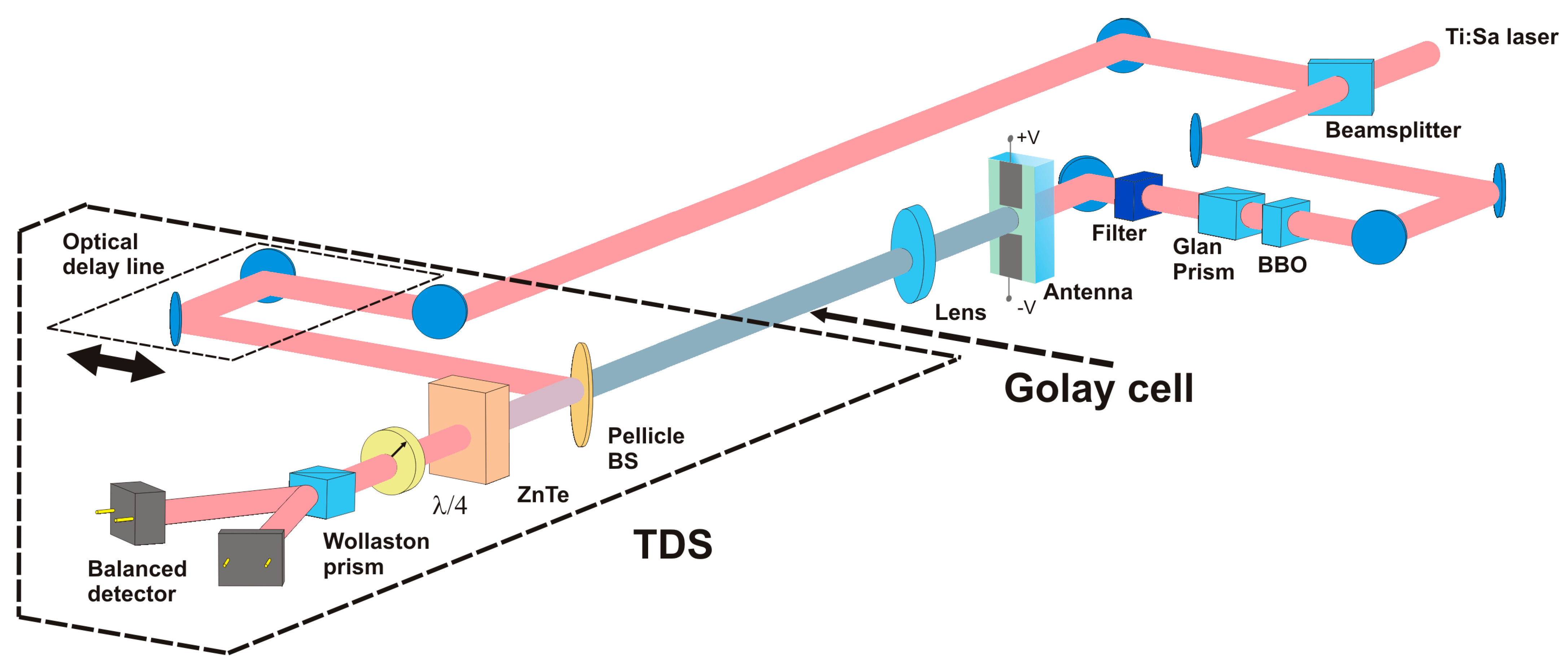
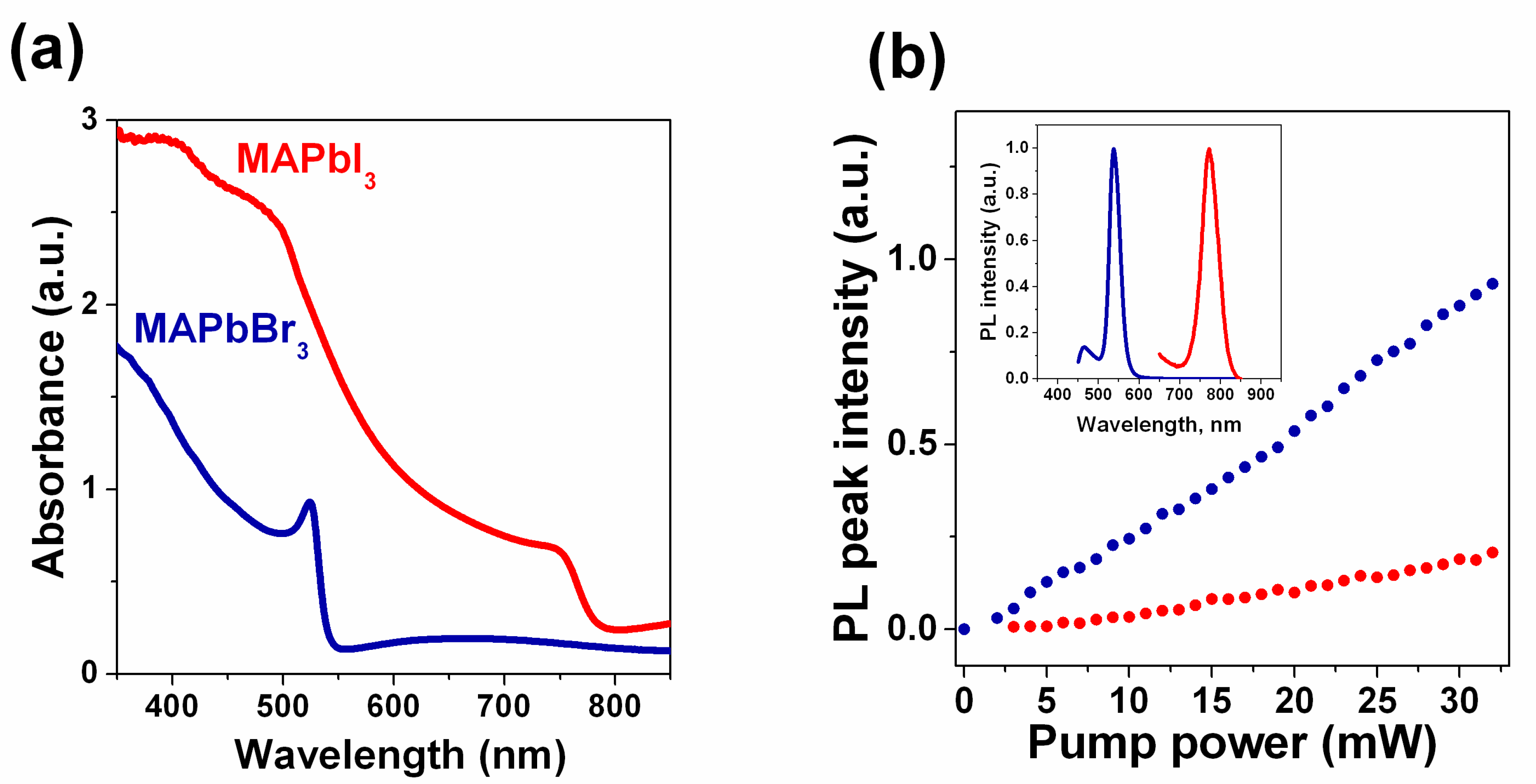
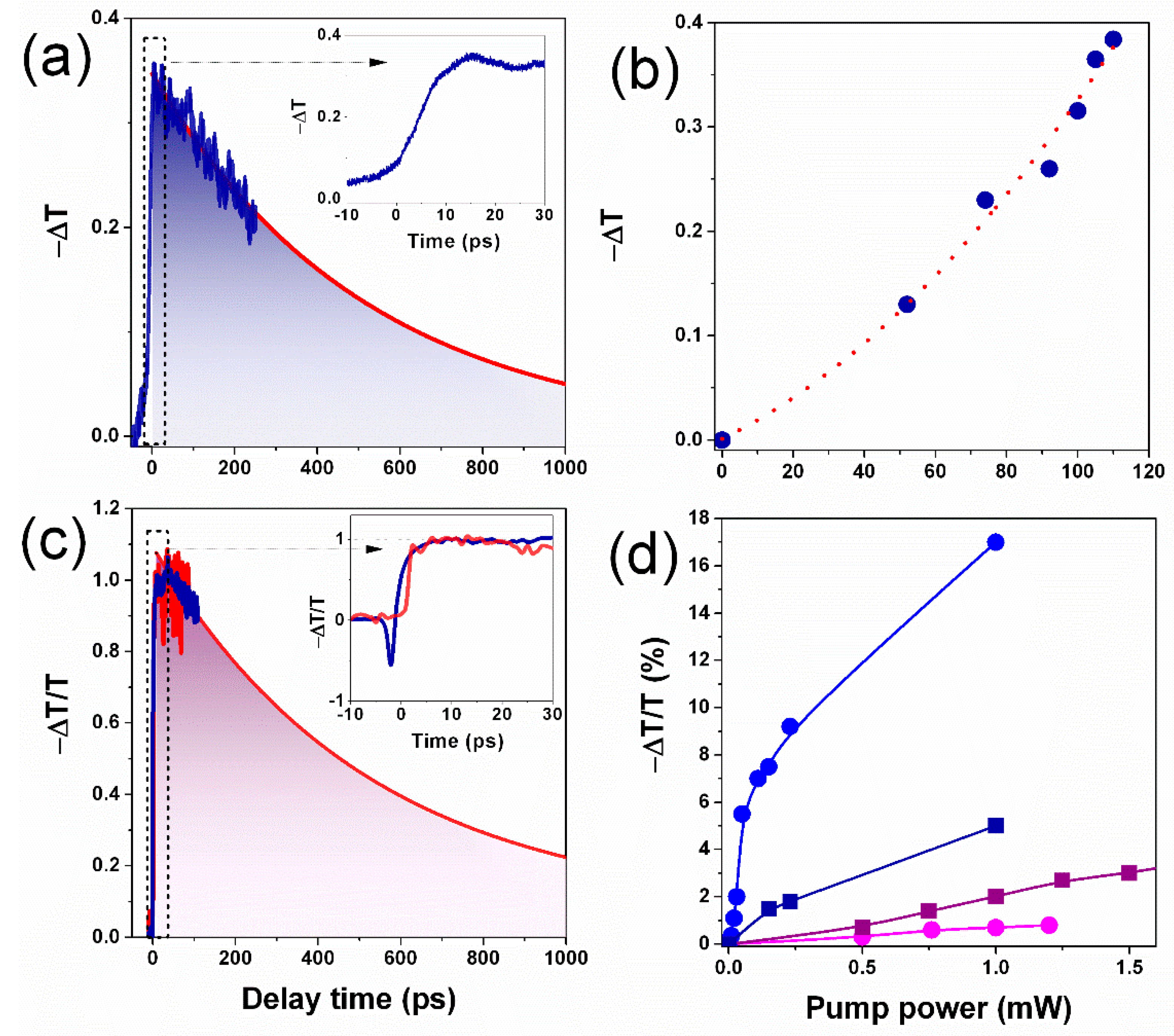
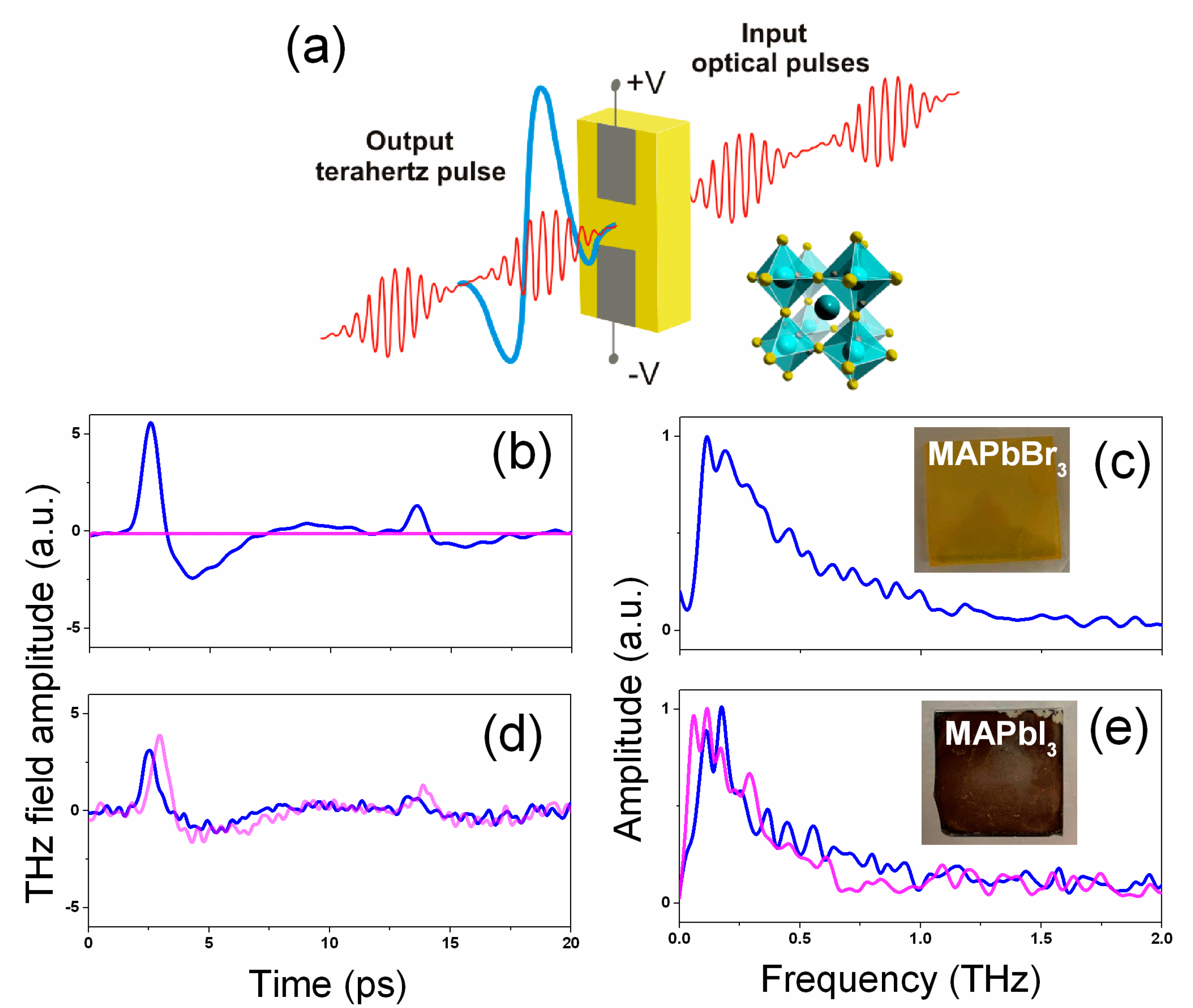

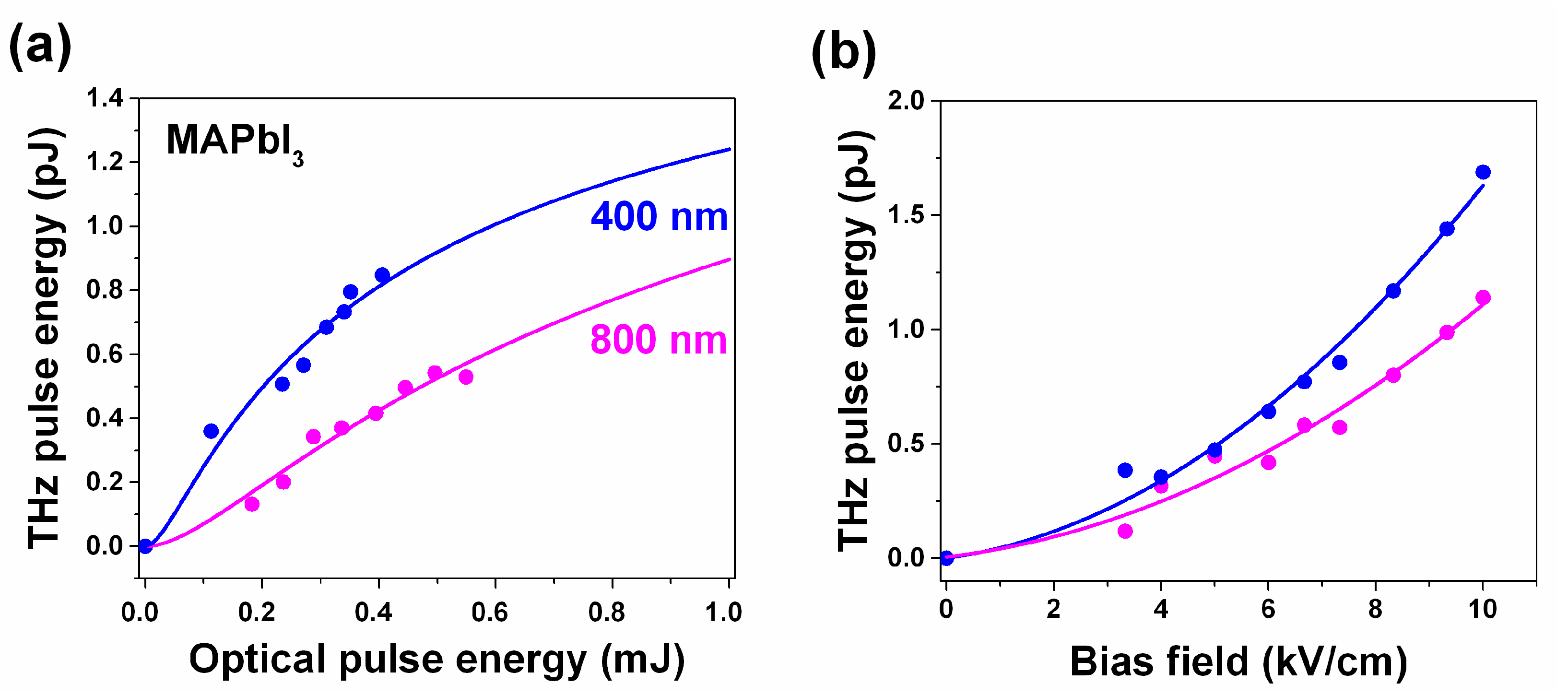
Publisher’s Note: MDPI stays neutral with regard to jurisdictional claims in published maps and institutional affiliations. |
© 2021 by the authors. Licensee MDPI, Basel, Switzerland. This article is an open access article distributed under the terms and conditions of the Creative Commons Attribution (CC BY) license (http://creativecommons.org/licenses/by/4.0/).
Share and Cite
Obraztsov, P.A.; Bulgakova, V.V.; Chizhov, P.A.; Ushakov, A.A.; Gets, D.S.; Makarov, S.V.; Bukin, V.V. Hybrid Perovskite Terahertz Photoconductive Antenna. Nanomaterials 2021, 11, 313. https://doi.org/10.3390/nano11020313
Obraztsov PA, Bulgakova VV, Chizhov PA, Ushakov AA, Gets DS, Makarov SV, Bukin VV. Hybrid Perovskite Terahertz Photoconductive Antenna. Nanomaterials. 2021; 11(2):313. https://doi.org/10.3390/nano11020313
Chicago/Turabian StyleObraztsov, Petr A., Vladislava V. Bulgakova, Pavel A. Chizhov, Alexander A. Ushakov, Dmitry S. Gets, Sergey V. Makarov, and Vladimir V. Bukin. 2021. "Hybrid Perovskite Terahertz Photoconductive Antenna" Nanomaterials 11, no. 2: 313. https://doi.org/10.3390/nano11020313
APA StyleObraztsov, P. A., Bulgakova, V. V., Chizhov, P. A., Ushakov, A. A., Gets, D. S., Makarov, S. V., & Bukin, V. V. (2021). Hybrid Perovskite Terahertz Photoconductive Antenna. Nanomaterials, 11(2), 313. https://doi.org/10.3390/nano11020313






